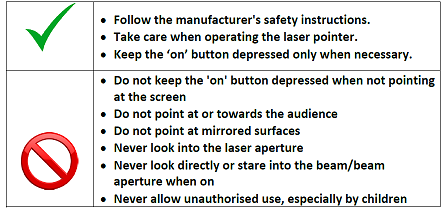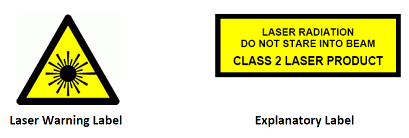Lasers
University Policy
- The University’s Management Procedure (‘Working with Lasers at the University of York’) should be consulted before purchase or use of laser equipment.
- The purpose of this document is to ensure the hazards arising from lasers are adequately controlled and minimise the risk of exposure to laser radiation in excess of the Maximum Permissible Exposure Limits (MPELs).
- The Management Procedure also describes the rules and procedures for all work at the University involving lasers. It defines and details the responsibilities of those involved in laser safety management, and embodies the recommendations and guidance in TR 60825-14: 2004: “Safety of Laser Products – Part 14 A Users Guide”.
Lasers Used in the Department of Biology
- The Department’s primary concern is ensuring the safety of all laser users. Some laser equipment can damage the eyes or skin, so may need a specific safety assessment to identity appropriate precautions.
- Workers in the department will commonly encounter lasers in the following equipment:
- Laser pointers: only laser pointers with a power output <1mW (Class 2 lasers) and classified in accordance with the British Standard (BS EN 60825-1) are permitted for use at the University. All Class 2 laser pointers must also have a warning label and explanatory label as described on p18 of the University’s Management Procedure (‘Working with Lasers at the University of York’). Users must not stare into the beam or direct the beam at other people. A Laser pointer can be loaned from Biology Reception. Frequent users of laser pointers are recommended to buy their own. Contact Biology Stores for recommended approved supplier(s).
- Confocal microscopes & Flow Cytometers: these may contain embedded class 3 or 4 lasers which would be dangerous if the optical components were to be removed from the apparatus
- Computer Equipment: normally totally sealed in and therefore safe
- Other Lasers (e.g. open lasers): such equipment requiring specific risk assessments.
- The safety implications of all lasers need to be discussed with the Departmental Laser Supervisor and the University Laser Safety Officer before purchase.
Laser classification
Class 1
- Lasers are inherently safe because the maximum permissible exposure (MPE) level cannot be exceeded under any conditions or safe by virtue of their engineering design.
- The typical allowed power for CW lasers is 40 μW (blue) and 400 μW (red).
Class 1M:
- Lasers that are safe under reasonably foreseeable conditions of operation, but may be hazardous if viewed using optical instruments. This can occur under two situations:
- Class 1M (high divergence) denoted 1Md unaided viewing is safe at normal distances but harmful levels of exposure can occur under close viewing (within 100 mm) with an eye loupe or magnifier.
- Class 1M (collimated) denoted 1Mc laser is collimated and has a large diameter, such that harmful exposure can occur under distant viewing with an optical instrument such as a telescope or binoculars.
Class 2
- Lasers that emit low levels of visible radiation where the aversion response, e.g. the blink reflex, normally affords eye protection. The typical allowed power for CW lasers is up to 1 mW.
Class 2M
- Lasers that emit visible radiation that exceeds the AEL for Class 2, but are safe for viewing due to the natural aversion response. This can occur under two situations:
- Class 2M (high divergence) denoted 2Md unaided viewing is safe at normal distances but harmful exposure can occur under close viewing with an optical instrument such as an eye loupe or magnifier.
- Class 2M (collimated) denoted 2Mc laser is collimated and has a large diameter, such that harmful exposure can occur under distant viewing with an optical instrument such as a telescope or binoculars.
Class 3R
- Lasers for which beam viewing is hazardous but the risk are lower than Class 3B. The typical allowed power for CW lasers is up to 5 mW (visible), 3.3 mW (810 nm), 40 μW (350 nm) and 12 nW (302.5 nm).
Class 3B
- Medium power lasers for which direct viewing and specular reflections are unsafe, but under certain conditions they may be safely viewed via a diffuse reflector. In general these conditions are:
i) a minimum viewing distance of 130 mm and
ii) a maximum viewing time of 10 seconds
- The typical allowed power for CW lasers is up to 500 mW.
- Users must register and be trained. Potentially harmful to eyes hence the beam must be enclosed.
Class 4.
- High power lasers for which viewing of intrabeam, specular reflections, and diffuse reflections are hazardous. Lasers may cause skin injuries and could also present a fire hazard. Their use requires extreme caution.
- These high powered lasers can only be used in Laser Designated Area which must be planned only after consultation with the appropriate advisers.
Registration and Risk Assessment of Lasers
- The Supervisor of Laser Work must register every Class 1Mc or 2Mc, Class 3R invisible, Class 3B or 4 lasers prior to first use. The laser registration form should be completed and submitted, along with a risk assessment, to the Departmental Laser Supervisor Dr Christoph Baumann, who will forward to the University Laser Safety Officer for approval.
- Laser Pointers: only use laser pointers with a power output of <1mW (Class 2 lasers) and classified in accordance with the British Standard. No other lasers should be used as pointers.
- Laser printers / CD & DVD drives etc: these lasers are normally well shielded by the manufacturers and users who follow the manufacturer's instructions will be adequately protected. There is no need to register these devices if they are being used as directed by the manufacturer.
Registration of Users
- Every intending user of Class 1M or Class 2M with an output more than five times the AEL for Class 1 or 2, Class 3R Invisible, Class 3B or Class 4 lasers must submit a Laser User Registration Form to the Departmental Laser Supervisor Dr Christoph Baumann, who will forward it to University Laser Safety Officer.
- Users of embedded lasers (lasers built into the equipment, such as confocal microscopes and cell sorters, and not normally accessible to users) do not have to register. However, any person who plans to modify or maintain embedded laser equipment, in such a way that they may gain access to the laser, must register. Users of high power lasers must have been trained before using the equipment.
Laser Safety Training
- Laser training is required for users of the following lasers:
- Class 1M and 2M Class 1M or Class 2M with an output more than five times the Class 1 or Class 2 AEL
- Class 3R Invisible
- Class 3B and Class 4
- Intending Laser Users should inform the Departmental Laser Supervisor (DLS) Dr Christoph Baumann
- read the Laser Safety Management Procedure
- attend the viewing of the 'LIMITS’ CD and passed the test section (pass of 70% required)
- attend the University’s formal training course ‘Laser Safety Awareness for University Laser Users’, or attend the next available session
- Upon receiving confirmation of laser user registration and before commencing any work with lasers, the laser user must:
- receive local training from the Supervisor on the specific procedures for the laser activity, including risk assessment, Local Rules, written instructions and contingency plans
- Laser User registration will be revoked if retraining is not completed within 5 years. In this case, if the individual needs to continue to use laser equipment, then the individual shall be closely supervised.
Laser Pointer Safety
It has been noted that some of the new pointers, which are readily available in the UK including both red and green devices, are more powerful than is appropriate. These devices pose a significant risk of eye injury to anyone exposed to the beam (5 to 500 mW’s). In addition, the classification of laser pointers from certain suppliers has been shown to be inadequate and many are incorrectly labelled. This is particularly concerning with the introduction of green laser pointers.
The eye is more sensitive to green light and so, although the power output may be similar, a green laser will appear brighter than a red laser. A correctly classified low powered green laser pointer should still pose a low risk, but individuals may experience some form of after image when it is displayed on a projection screen, particularly when viewed from close-by.
If the green laser pointer is incorrectly classified, particularly one that emits a pulse of energy, then the risk may be significant. If in doubt please don’t use the pointer.
It is the policy of The University of York that any laser pointers used by staff and students must have a power output of <1mW (Class 1 and Class 2 in accordance with BS EN 60825-1).
Laser pointers above Class 2 MUST NOT BE USED.
Laser pointers should only be used as a pointing device and securely stored when not in use. Persons who use laser pointers should ensure that they are aware of potential hazards and they should comply with the basic instructions.
Instructions for use
When operating laser pointers, users must ensure that they use them in a safe manner and do not expose themselves or others to the beam. Laser pointers are not to be modified in any way.

Labelling
Your laser pointer must be labelled to indicate its classification. The label should look similar to the one shown below:

If your laser pointer does not have such a label, or the label indicates that it is a class greater than 2, then it must NOT be used at The University of York.
Device requirements
- Laser Pointers must not exceed Class 2 (≤1 mW output power) whenever there is uncertainty they must not be used as laser pointers.
- Laser Pointers must be purchased from reputable manufacturers and suppliers.
- Laser Pointers must not be modified.
Conditions of use
- Ambient lighting should be kept as high as practicable - blackout conditions should be avoided whenever practicable.
- Laser Pointers must not be directed towards eyes.
- Prior to use, checks should be made that there are no reflective surfaces that could foreseeably redirect the laser beam towards eyes (user and audience).
- Departments / Units are required to take steps to ensure that all relevant persons are made aware of this guidance, including visitors to the University of York.
Further recommendations
- The use of green or 630nm red waveband laser pointers is recommended. These wavelengths afford greater visibility per unit power.
- If visiting another establishment and intending to use a laser pointer, you should first check the local regulations.
Further guidance on laser pointers can be found on the HPA’s website:
http://www.hpa.org.uk/web/HPAweb&HPAwebStandard/HPAweb_C/1195733794576
